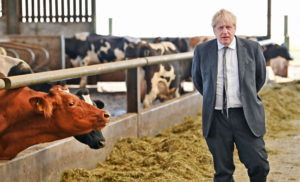In the deep ocean, occasionally, a whale carcass falls to the bottom of the sea. Most of the time, in the state of nature, creatures have just about enough to survive. But the first creatures to find the whale have more food than they could ever eat. These scavengers live lives of extraordinary plenty — some of the smaller, faster-breeding species might do so for several generations. There is enough to go around a thousand times over. For a while.
And then the whale is gone, and the creatures go back to their lives of crushing pressure, constant darkness, and an eternal knife-edge struggle for survival. As Thomas Malthus had it in his bleak vision: organisms, which increase exponentially in number, will rapidly outgrow their resources, which can only grow arithmetically. So of course, the excess population which has grown up on this brief glut must die off
We are currently living in a time of whalefall, suggests the scientist Vaclav Smil in his new book, How the World Really Works. He doesn’t use the word, of course: credit for the macabre whale metaphor must go to Scott Alexander. But modern humans are animals, products of evolution like any other, and yet we noticeably do not spend every minute of every day struggling to get the material required to survive. Instead, we build cathedrals and watch football, we make art, we waste time on Twitter. And that is because we live on the gigantic, blessed whale carcass that is our fossil fuel inheritance.
For Smil, our discussions about climate and energy are hamstrung, because so few people actually understand how the world really works. Material lands in front of us in pre-packaged, convenient forms — shrink-wrapped pork chops, winter strawberries, lights that turn on when you flick a switch, phones made of plastic and metal. The world is a set of black boxes that we use but, in most cases, do not understand. So when we say “we need to cut back our carbon emissions”, most of us don’t really grasp the implications of doing so.
But somehow, all these incomprehensible processes are keeping us alive, and we should find it astonishing that they are able to do so. The demand for material – for energy and nutrients – is greater than it has ever been. The world’s population has exploded: in 1800, there were about 1 billion humans. In 1950, there were 2.5 billion. Now there are 7.7 billion. In my parents’ lifetime, the number of humans alive has trebled. But amazingly, the amount of material available to each of them has increased even more, and that is in large part because of our use of fossil fuels.
In 1800, almost all the energy used globally was in the form of human and animal muscles, for mechanical work, or plant matter, burned for heat and light. Coal, the first widely used fossil fuel, was just starting to be used in steam engines in the UK, but it was negligible overall. By 1900, fossil fuels were the source for half our energy. By 2000, they were the source of 87%.
And as a result, our lives have been transformed. The amount of energy available to the world has increased 1,500-fold. That is only part of the story, though: increased energy efficiency means that the gain in useful energy is more like 3,500 times. And even though the world’s population has gone up many times, “an average inhabitant of the Earth nowadays has at their disposal nearly 700 times more useful energy than their ancestors had at the beginning of the 19th century”.
But most of us don’t realise how that energy is actually used. A large percentage, for instance, is used to create four materials which are the building blocks of modern society – materials which are so ubiquitous that we barely notice them, even as we depend on them.
Smil identifies these four basic pillars of human civilisation as steel, cement, plastic and ammonia. Producing them takes enormous amounts of fossil fuels. It takes, for instance, 25 gigajoules of energy to produce one ton of steel, roughly twice the amount of energy used by the average UK household per year. In 2019, the world used 1.8 billion tons of steel; its production is responsible for about 8% of the world’s total carbon emissions. But we can’t do without it: the frameworks of our cities are built of it; the pipes we send our water and gas through, too. Our cars, our transporter ships, our knives and cooking pots. Our machines for making all these things. Cement and plastic are similarly vital, and are responsible for comparable amounts of our total carbon output. We can’t do without them, and there’s no easy carbon-free alternative way of making them.
And then there’s ammonia, which rarely features in any conversation about cutting carbon emissions. Ammonia is a nitrogen atom ringed by four hydrogen atoms. Our atmosphere is 80% nitrogen by mass, but plants – which need it for growth – can’t easily take it out of the air. Instead they need to gather it from the soil. Bacteria that live in the roots of some plants can “fix” it into the soil; animal wastes like manure have relatively high nitrogen content. But those methods can only support a certain amount of growth.
In the beginning of the 20th century, a German chemist called Fritz Haber invented a process for getting nitrogen out of the air by making ammonia. It requires huge amounts of energy, and hydrogen, usually taken from natural gas. We now spread hundreds of millions of tons of ammonia on our fields — about 50% of the total nitrogen going into food production comes from it. Smil quotes an author, writing in 1971: “industrial man no longer eats potatoes made from solar energy; now he eats potatoes partly made of oil.”
This means the world is able to eat. The share of the global population that is underfed has plummeted, even as the actual population has ballooned – about 65% of people could not get enough to eat in 1950, compared to about 9% in 2019. So, “in 1950 the world was able to supply adequate food to about 890 million people,” as Smil puts it: “but by 2019 that had risen to just over 7 billion”. That is not entirely down to ammonia, but ammonia is a large part of the story. If fertiliser were removed, perhaps half the world’s population would starve.
Agriculture, then, depends on the whalefall: the glut of energy provided by fossil fuels. Our deep reliance on fossil fuels, to create materials most of us don’t appreciate we need, is unnerving. Especially when Smil points out that much of the world — notably, sub-Saharan Africa — lives on well below average levels of energy use. Africa uses just 5% of the world’s total ammonia supplies, despite having almost 25% of the population. About 40% of the world — 3.1 billion people — has a per capita energy supply “no higher than the rate achieved in both Germany and France in 1860”. “In order to approach the threshold of a dignified standard of living,” writes Smil, “those 3.1 billion people will need at least to double — but preferably triple — their per capita energy use.”
Can we do that while also reducing our carbon emissions? Not fast, says Smil. For all the boasts and pledges — all the “government targets for years ending in zero or five”, about which Smil is very sniffy — the world relies too heavily on fossil fuels, for too many things, to rapidly stop using them. Even the International Energy Association’s optimistic “Sustainable Development Scenario” projects that the share of fossil fuels in the world’s energy mix will only drop to 56% in 2040
We can, and need to, replace fossil-fuel energy sources with renewable ones. But there are obstacles, beyond simply the political will. Renewable energy is very good at making electricity. But electrical energy isn’t ideal for making the incredible heat needed for iron and steel production, or cement. The Haber process for making ammonia works much more efficiently with natural gas as the source of hydrogen and energy than it does with water and electricity.
And away from the four pillars, fossil fuels have other huge advantages. It’s very energy-dense: you can store much more energy in a kilogram of kerosene than you can in a kilogram of battery, meaning that transatlantic flights are possible. And it keeps — currently, there is no suitable way of storing electrical energy for more than a few hours or days, so solar energy stored up in summer is no use in winter. A barrel of oil will last indefinitely. Those facts will change, and Smil is more downbeat than I am about how quickly that will happen, but we are definitely going to be relying on fossil fuels for some decades yet.
But unlike the crabs and hagfish that eat the fallen whale, we are clever, and we needn’t simply slink back into the darkness and starve. Smil thinks there are major gains in efficiency which can be had, over and above the enormous gains so far. He points to water use as an example: in 2015, the US only used about 4% more water than it did in 1965, but in the meantime, its population had gone up by two thirds actual per capita water use has dropped by 40%, even while the country has got richer and better fed. Perhaps similar efficiencies can be found with energy and carbon.
Besides, we are not about to run out of whale, at least not imminently: the raw materials — metals, fuels — that our lifestyle needs are still around in large amounts. But we have grown in numbers and lifestyle well beyond the capacity of the pre-whalefall world. And we don’t want to go back to the lifestyle we had before, even if some romantics and millenarians might disagree. In fact, we want many more people to enjoy the spoils of whalefall. We have used fossil fuels to construct an astonishing world, one that feeds and houses an incredible number of people.
We need to wean ourselves off fossil fuels, and the sooner the better. But it will be a long and difficult job — as Smil demonstrates, they are threaded through our society at every level, entwined like knotweed in the systems that provide our food, our housing, our machinery, our transport. We forget how complex our society is until it stops working in some way — as when supply chains broke down in the pandemic and our hospitals ran out of rubber gloves (an issue Smil talks about in a section on globalisation). As it stands, if we were to reduce fossil fuel consumption by the sort of degrees that some demand, it would lead to disaster, because we haven’t unpicked the threads yet.
Disclaimer
Some of the posts we share are controversial and we do not necessarily agree with them in the whole extend. Sometimes we agree with the content or part of it but we do not agree with the narration or language. Nevertheless we find them somehow interesting, valuable and/or informative or we share them, because we strongly believe in freedom of speech, free press and journalism. We strongly encourage you to have a critical approach to all the content, do your own research and analysis to build your own opinion.
We would be glad to have your feedback.
Source: UnHerd Read the original article here: https://unherd.com




